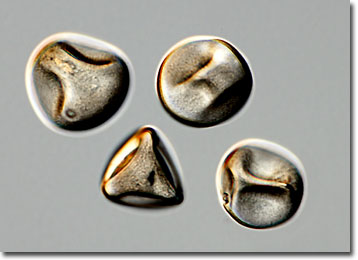Differential Interference Contrast Image Gallery
Timothy Grass Pollen
Though not native to North America, timothy grass is the most important commercial perennial grass grown in the United States. It is cultivated widely for use as hay and generates hundreds of millions of dollars in revenue each year.

Sometimes referred to as herd’s grass, timothy typically grows about three feet high and features non-branching panicles, or clusters of flowers. Each dense panicle is about 2 to 3 inches long and cylindrical in shape. The stems of timothy grass generally grow in large tufts and exhibit distended, bulb-like bases. The vascular plants also tend to shed large amounts of pollen and primarily pollinate in the morning hours of late spring or early summer, depending on geographical location.
Over 9,000 species of grass are currently in existence and only a small percentage of those are known to cause allergic reactions in humans. Included in the allergy-causing grasses is timothy, which contains a protein called PHL P II in its pollen grains. PHL P II is one of the world’s major plant allergens and, until recently, the only method for its control has been antihistamine medications. Scientists are, however, currently attempting to create a synthetic hypoallergenic vaccine that would provide easy, ongoing relief for many of those that suffer from pollen allergies.
